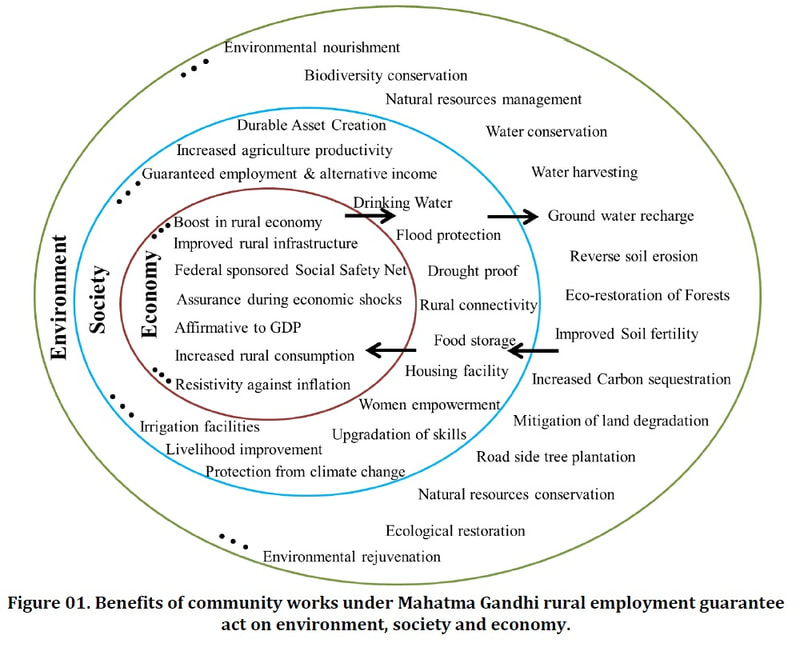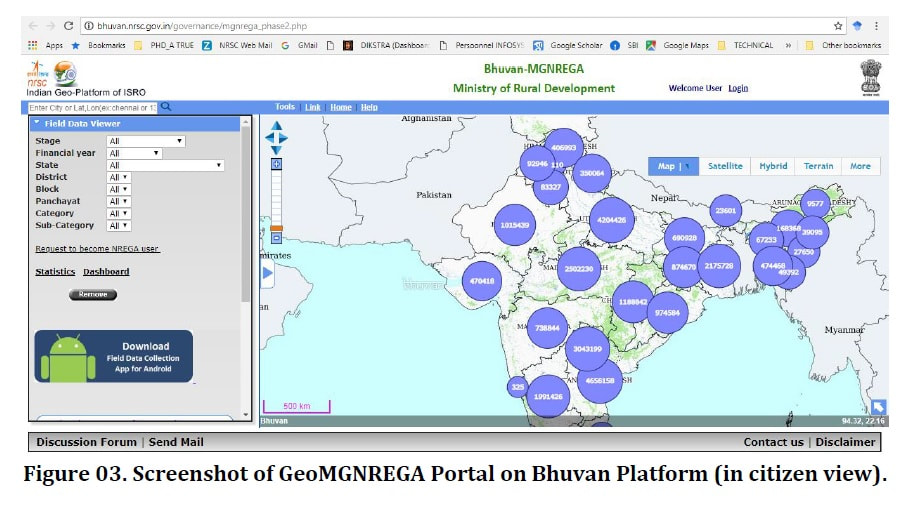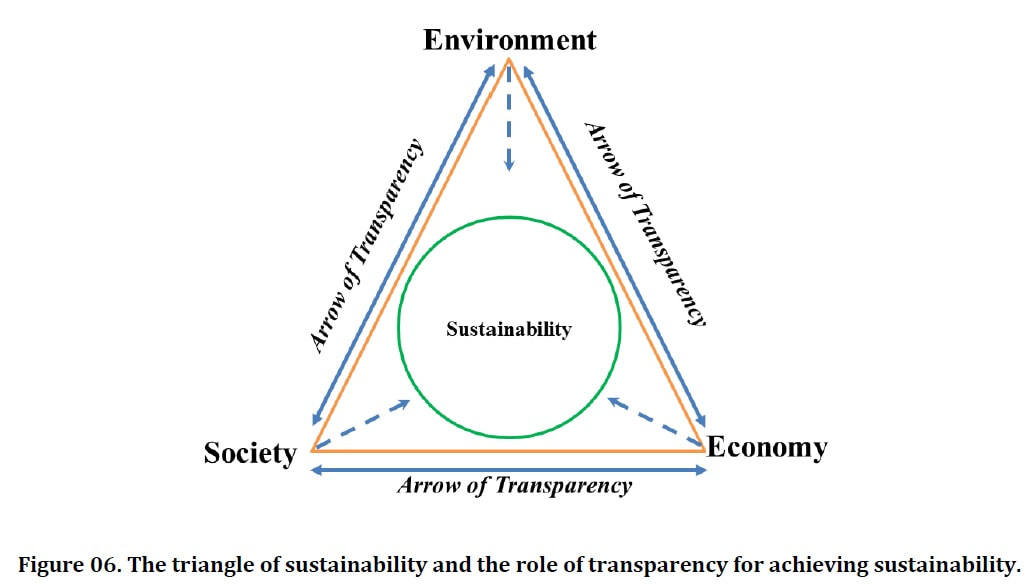J. Sci. Technol. Environ. Inform. | Volume 07, Issue 02, 533-543| https://doi.org/10.18801/jstei.070219.55
Article type: Research article, Received: 12.02.2019, Revised: 04.05.2019, Date of Publication: 14 May 2019.
Article type: Research article, Received: 12.02.2019, Revised: 04.05.2019, Date of Publication: 14 May 2019.
Transparency helps in balancing the environment, society and economy: lessons from the world’s largest public works program
Dandabathula Giribabu 1, Ch. Sudhakar Reddy 2 and Prasada Rao V.V. Peddineni 3
1 Regional Remote Sensing Centre–West, NRSC/ISRO, Dept. of Space, Jodhpur, India.
2 National Remote Sensing Centre (NRSC), ISRO, Dept. of Space, Hyderabad, India.
3 Andhra University, Vishakhapatnam, India.
1 Regional Remote Sensing Centre–West, NRSC/ISRO, Dept. of Space, Jodhpur, India.
2 National Remote Sensing Centre (NRSC), ISRO, Dept. of Space, Hyderabad, India.
3 Andhra University, Vishakhapatnam, India.
Abstract
Sustainable development depends on the complex set of interactions between the natural environment, the society we live and economic conditions. The relationship between humans and the environment is like 'one will give and other will take', during which equilibrium may get distracted. Economics leverages the growth potential of the society and society is influenced by the natural environment. To maintain the equilibrium between these three pillars of sustainable development there is a need to link them. Transparency during the execution of large-scale projects plays a pivotal role in achieving sustainable development and enables the balance between the environment, society, and economy. In recent times, the governments of many countries have adopted programs for improving the living standards, food security and improved nutrition, health, clean water and sanitation, education, and other aspects of sustainable development goals. This article reports the transparency methods that are implemented for MGNREGA project and articulates the role of transparency in linking between the three dimensions of sustainable development: environment, society, and economics. The paper emphasizes that the mechanism of transparency should reside in all sides of the triangle of sustainability.
Key Words:
Transparency, Communication Technology, Governance, Environment, Economy and Society
Sustainable development depends on the complex set of interactions between the natural environment, the society we live and economic conditions. The relationship between humans and the environment is like 'one will give and other will take', during which equilibrium may get distracted. Economics leverages the growth potential of the society and society is influenced by the natural environment. To maintain the equilibrium between these three pillars of sustainable development there is a need to link them. Transparency during the execution of large-scale projects plays a pivotal role in achieving sustainable development and enables the balance between the environment, society, and economy. In recent times, the governments of many countries have adopted programs for improving the living standards, food security and improved nutrition, health, clean water and sanitation, education, and other aspects of sustainable development goals. This article reports the transparency methods that are implemented for MGNREGA project and articulates the role of transparency in linking between the three dimensions of sustainable development: environment, society, and economics. The paper emphasizes that the mechanism of transparency should reside in all sides of the triangle of sustainability.
Key Words:
Transparency, Communication Technology, Governance, Environment, Economy and Society
Article Full-Text PDF
| 55.02.07.19_transparency_helps_in_balancing_the_environment_society_and_economy_lessons_from_the_world’s_largest_public_works_program.pdf | |
| File Size: | 2001 kb |
| File Type: | |
|
Share This Article
|
|
Article Citations
MLA
Giribabu, D. et al. “Transparency helps in balancing the environment, society and economy: lessons from the world’s largest public works program.” Journal of Science, Technology and Environment Informatics 07(02) (2019): 533-543.
APA
Giribabu, D., Reddy, C. S. and Pedineni, P. R. V. V. (2019). Transparency helps in balancing the environment, society and economy: lessons from the world’s largest public works program. Journal of Science, Technology and Environment Informatics, 07(02), 533-543.
Chicago
Giribabu, D., Reddy, C. S. and Pedineni, P. R. V. V. “Transparency helps in balancing the environment, society and economy: lessons from the world’s largest public works program.” Journal of Science, Technology and Environment Informatics 07(02) (2019): 533-543.
Harvard
Giribabu, D., Reddy, C. S. and Pedineni, P. R. V. V. 2019. Transparency helps in balancing the environment, society and economy: lessons from the world’s largest public works program. Journal of Science, Technology and Environment Informatics, 07(02), pp. 533-543.
Vancouver
Giribabu, D, Reddy, CS and Pedineni, PRVV. Transparency helps in balancing the environment, society and economy: lessons from the world’s largest public works program.Journal of Science, Technology and Environment Informatics. 2019 May 07(02): 533-543.
Giribabu, D. et al. “Transparency helps in balancing the environment, society and economy: lessons from the world’s largest public works program.” Journal of Science, Technology and Environment Informatics 07(02) (2019): 533-543.
APA
Giribabu, D., Reddy, C. S. and Pedineni, P. R. V. V. (2019). Transparency helps in balancing the environment, society and economy: lessons from the world’s largest public works program. Journal of Science, Technology and Environment Informatics, 07(02), 533-543.
Chicago
Giribabu, D., Reddy, C. S. and Pedineni, P. R. V. V. “Transparency helps in balancing the environment, society and economy: lessons from the world’s largest public works program.” Journal of Science, Technology and Environment Informatics 07(02) (2019): 533-543.
Harvard
Giribabu, D., Reddy, C. S. and Pedineni, P. R. V. V. 2019. Transparency helps in balancing the environment, society and economy: lessons from the world’s largest public works program. Journal of Science, Technology and Environment Informatics, 07(02), pp. 533-543.
Vancouver
Giribabu, D, Reddy, CS and Pedineni, PRVV. Transparency helps in balancing the environment, society and economy: lessons from the world’s largest public works program.Journal of Science, Technology and Environment Informatics. 2019 May 07(02): 533-543.
References
- Bertot, J. C., Jaeger, P. T. and Grimes, J. M. (2010). Using ICTs to create a culture of transparency: E-government and social media as openness and anti-corruption tools for societies. Government Information Quarterly, 27, 264-271. https://doi.org/10.1016/j.giq.2010.03.001
- Bhat, J. A. and Yadav, P. (2015). MGNREGA: A pathway for achieving sustainable development. International Journal of Engineering Technology, Management and Applied Sciences, 3, 339-347.
- Bhattacharjee, G. (2017). MGNREGA as distribution of Dole. Economic and Political Weekly, 52, 25-26.
- Bhosale, V. P. and Bhole, J. (2018). A role of MGNREGA scheme for sustainability of beneficiary households and rural asset creation to empower rural women in JALGAON district. International Journal of Scientific Research and Review, 7, 88-93.
- Brundtland, G., Khalid, M., Agnelli, S., Al-Athel, S., Chidzero, B. and Fadika, L. (1987). Our common future (Brundtland Report). United Nations World Commission on Environment and Development, 1987. Retrieved from http://www.un-documents.net/our-common-future.pdf
- eFMS. (2016). Electronic Fund Management System. Ministry of Rural Development. Retrieved from http://mgnrega.nic.in/netnrega/data/efms%20manual_ritesh_v5_10may2012.pdf
- Epremian, L., Lujala, P. and Bruch, C. (2016). High-value natural resources and transparency: accounting for revenues and governance. Oxford Research Encyclopaedia of Politics. https://doi.org/10.1093/acrefore/9780190228637.013.21
- Esteaves, T., Rao, K. V., Sinha, B. and Roy, S. S. (2013). Environmental benefits and vulnerability reduction through Mahatma Gandhi NREGS: A Synthesis Report. Ministry of Rural Development, Government of India and Deutsche GIZ, New Delhi.
- Florini, A. (2007). The right to know: transparency for an open world. Columbia University Press, New York. https://doi.org/10.7312/flor14158
- Folke, C., Biggs, R., Norström, A. V., Reyers, B. and Rockström, J. (2016). Social-ecological resilience and biosphere-based sustainability science. Ecololgy and Society, 21. https://doi.org/10.5751/ES-08748-210341
- Goldin, C. (2001). The human-capital century and American leadership: Virtues of the past. The Journal of Economic History, 61, 263-292. https://doi.org/10.1017/S0022050701028017
- Griggs, D., Stafford-Smith, M., Gaffney, O., Rockström, J., Öhman, M. C. and Shyamsundar, P. (2013). Sustainable development goals for people and planet. Nature, 495(7441), 305. https://doi.org/10.1038/495305a
- Hess, D. (2007). Social reporting and new governance regulation: The prospects of achieving corporate accountability through transparency. Business Ethics Quarterly, 17, 453-476. https://doi.org/10.5840/beq200717348
- ISRO Bhuvan. (2019). Retrieved from https://www.isro.gov.in/isros-geo-portal-bhuvan-gateway-to-indian-earth-observation.
- Matiyabu, I. I., Ndayizigamiye, P. and Maharaj, M. (2017). The role of ICT in enhancing transparency and accountability in public funds management in DRC. In IST-Africa Week Conference (IST-Africa), IEEE. https://doi.org/10.23919/ISTAFRICA.2017.8102291
- MGNREGA Dashboard. (2019). Retrieved from http://mnregaweb4.nic.in/netnrega/all_lvl_details_dashboard_new.aspx
- MGNREGA Library. (2019). Retrieved from http://nrega.nic.in/netnrega/library.aspx
- MGNREGA Reports. (2019). Retrieved from http://mnregaweb4.nic.in/netnrega/MISreport4.aspx
- Munasinghe, M. (2002). The sustainomics trans-disciplinary meta-framework for making development more sustainable: applications to energy issues. International Journal of Sustainable Development, 5, 125-182. https://doi.org/10.1504/IJSD.2002.002563
- NREGA Portal (2018). Mahatma Gandhi National Rural Employment Guarantee Act. Retrieved April 8, 2019 from http://nrega.nic.in/netnrega/mgnrega_new/Nrega_home.aspx.
- Paul, B. D. (2008) Sustainable Development – A Theoretical Approach. Annals of the University of Oradea, Economic Science Series, 17(2), 581-585.
- Pezzey, J. (1989). Economic analysis of sustainable growth and sustainable development. World Bank. Washington DC.
- Rajović, G. and Bulatović, J. (2013). Natural and social conditions for economic development: Case study North-eastern Montenegro. Hyperion Economic Journal, 1, 28-42.
- Richardson, B. J. and Razzaque, J. (2006). Public participation in environmental decision-making. Environmental law for sustainability, 6,165-194.
- Sharma, A. (2010). Rights-based legal guarantee as development policy: The Mahatma Gandhi National Rural Employment Guarantee Act. UNDP India. New Delhi.
- Sharma, A. K., Sarma, A., Kaur, C. and Tayal, C. (2016). Macroeconomic impact of the MGNREGA work scheme in India. PEP Policy Brief.
- Sustainable Development (2015). Poverty Eradication. Retrieved from https://sustainabledevelopment.un.org/topics/povertyeradication
- Tiwari, R., Somashekhar, H. I., Parama, V. R., Murthy, I. K., Kumar, M. S. M., Kumar, B. K. M., Parate, H., Varma, M., Malaviya, Rao, S. A. S., Sengupta, A., Kattumuri, R. and Ravindranath, N. H. (2011). MGNREGA for environmental service enhancement and vulnerability reduction: rapid appraisal in Chitradurga district, Karnataka. Economic and Political Weekly, 46(2).
- Toman, M. A. (2003). The roles of the environment and natural resources in economic growth analysis. Resources for the Future. Retrieved from https://ageconsearch.umn.edu/bitstream/10510/1/dp020071.pdf
- Tracey, S. and Anne, B. (2008). OECD insights sustainable development linking economy, society, environment: Linking economy, society, environment. OECD Publishing. Retrieved from http://www.sjalfbaerni.is/media/frodleikur/OECD-skyrsla.pdf
- UN-DESA (2013). World economic and social survey 2013: Sustainable development challenges. Department of Economic and Social Affairs, United Nations. Washington DC.
- World Bank Group. (2016). Global Monitoring Report 2015/2016: Development Goals in an Era of Demographic Change. Washington, DC: World Bank.
- World Bank. (2018).The State of Social Safety Nets 2018. World Bank, Washington, DC. https://doi.org/10.1596/978-1-4648-1254-5
- Yu, L. and Gong, P. (2012). Google earth as a virtual globe tool for earth science applications at the global scale: progress and perspectives. International Journal of Remote Sensing, 33, 3966-3986. https://doi.org/10.1080/01431161.2011.636081
© 2019 The Authors. This article is freely available for anyone to read, share, download, print, permitted for unrestricted use and build upon, provided that the original author(s) and publisher are given due credit. All Published articles are distributed under the Creative Commons Attribution 4.0 International License.
Journal of Science, Technology and Environment Informatics, EISSN 2409-7632.


